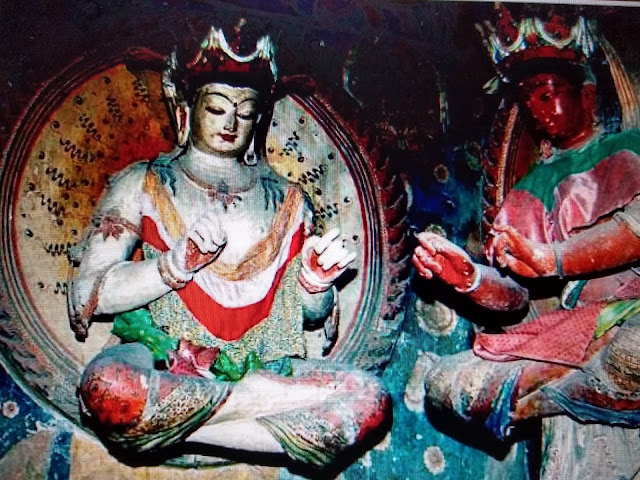Presentation by Prajwal Guruju on ' Vajradhatu Practice in Newar Buddhism'
By Dr Rabin Man Shakya
| Portland, (Nepal Oregon News): A scholarly presentation entitled "Vajradhatu Practice in Newar Buddhism" was made by Guru Prajwal Vajracharya, co-founder of Portland's Nritya Mandala Mahavihara in the zoom program hosted by Yangchema Arts & Music, California and organized by Core of Culture, Chicago on Tuesday, July 6, 2021. |
The virtual event was participated by 65 distinguished personalities including professors and academic figures.
Guru Vajracharya, foremost exponent of the oldest known form of Buddhist ritual expression, during the presentation, expanded on his earlier talk about 'mudra', by presenting "Diamond Spheres, the Vajradhatu," as it is lived and practiced in Newar Buddhist traditions.
An erudite scholar on Newar Vajrayana Buddhism, Guru Prajwal examined the dimensions and realities of Vajradhatu rituals in Nepal and demonstrated how essential the act of embodiment is to Buddhist practice. The Newar traditions precede the Tibetian Vajrayana by hundreds of years.
Addressing the zoom gathering, Guru Prajwal, also a Buddhist Gubhaju (priest), said:"Vajra means thunderbolt or diamond sphere or essence and is used as a ritual object to symbolize the undestroyable diamond power and irresistible force of thunderbolt."
Underlining the effects of Vajra, he said that a common Vajra has only 4 Dhars (stripes) while an extended and intricate Vajra has 8 stripes, and when both Vajras are united, it becomes a Vishwo Vajra (global Vajra).
Speaking about Dhatu, he said:"Dhatu is a Sanskrit term for the seven fundamental elements of the body: Rasa Dhatu, Rakta Dhatu, Mamsa Dhatu, Medha Dhatu, Asthi Dhatu, Majja Dhatu and Shukra Dhatu."
When Vajra and Dhatu are united together, it becomes Vajradhatu, said Vajracharya and added:"Vajradhatu is a metaphysical space inhabited by 53 deities including Pancha Buddhas -- Vairochana, Amitabha, Amoghasiddhi, Akshovya, Ratnasambhava, 16 Mahabodhisattvas, 16 Bhadrakalpa Bodhisattvas, 8 Offering Goddesses and 8 Dvarapalas."
According to Newar Vajrayana Buddhism, the whole universe is moving about and revolving around the Vajradhatu's fundamental principles, Guru Vajracharya went on saying.
He said:"Vajradhatu rituals and practice date back to thousands of years in Newar Vajrayana Buddhism. There are more than 4,000 Vajradhatu Chaityas in Nepal. Similarly, there are a number of Dharma Dhatu stupas in the Kathmandu valley. Swayambhu stupa is the most ancient Dharmadhatu stupa of Nepal."
The subtle difference between Vajradhatu and Dharmadhatu chaityas is: a vajradhatu chaitya consists of 53 deities while in Dharmadhatu chaitya, we can also find the spouses of deities -- the Tara deities too, he added.
Talking about Vajradhatu and Dharmadhatu, Guru Prajwal said that Dharmadhatu is more complex and intricate than the Vajradhatu.
Gautama Buddha was born in Nepal. The previous Buddhas before Siddhartha Gautama Buddha -- Vipashwi Buddha, Shikhi Buddha, Vishwobhu Buddha, Krakuchanda Buddha, Kanakmuni Buddha, Kashyap Buddha -- all of these great Buddhas had visited Nepal Mandala being a holy and sacred place. Similarly, Vajradhatu as well as Dharmadhatu originated in Nepal. Despite all this, Nepal is taking a backseat in the Buddhist sphere, he said.
He concluded:"The historical irony of Nepal is -- Nepal has been ruled by non-Buddhist kings since 12th century onwards and important records and evidences about Buddhism have been destroyed or lost."
Prior to the presentation, Guru Prajwal Vajracharya was introduced to the virtual participants by Joseph Houseal, Director of Core of Culture.
Guru Prajwal's presentation was a part of "Mudra & the Diamond Sphere: Part Two", lecture series along with Dr Thinles Dorje and Dr Vena Ramphal".
This was Core of Culture's international cultural preservation initiative with lead support from the Robert H N Ho Family Foundation and additional support from the Kipper Family Foundation.
Prajwal Vajracharya is a 35th generation Tantric Buddhist priest from Nepal and ritual master of the Charya Nritya dance tradition and other ritual forms. Prajwal began his training in Charya Nritya, the dance aspect of Newar Buddhism, from the age of eight, receiving formal instruction from his father, the Buddhist scholar and ritual master Ratna Kaji Vajracharya.
Guru Prajwal is now the foremost teacher, practitioner and performer of the tradition. He is a veteran of several world tours. He teaches beginning and advanced students around the globe. He founded Dance Mandal in 1996, and the Foundation for Sacred Buddhist Arts of Nepal to preserve and expand this rare ancient form of Buddhism and its related traditions.
( Nepal Oregon News writer Rabin Man Shakya, who is a Newah journalist in USA, is also a Life Member of World Newah Organization.)






